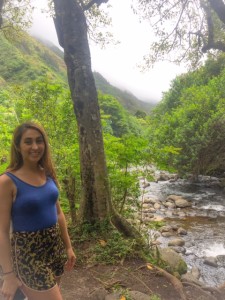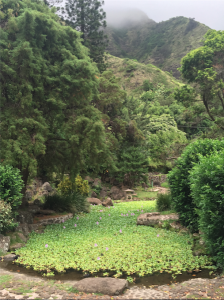On my latest adventure, I recently traveled to Maui, one of the gorgeous Hawaiian Islands. I had the opportunity to visit the ‘Iao Valley. As I stepped along the path that winds around streams and mountains, I observed how majestic this place truly is and I understand why it is a sacred location to the Hawaiians. It is a peaceful slice of heaven, yet has also set the stage for a tumultuous history full of Hawaiian gods, kings and warriors.

The ‘Iao Valley became a National Natural Landmark in 1972. The 47,000 acres of the ‘Iao Valley demonstrate the major episodes of volcanic activity that created the older, western portion of the island of Maui. This monument is one of the seven such Hawaii landmarks, which also includes Diamond Head on O’ahu.
Ka Wai Ola O Kãne (The Living Waters of Kãne)
‘Iao translates to “cloud supreme” and refers to the imposing clouds that hover over the mountains and valley. These clouds bring frequent rains that feed the cool streams that wind through the valley. It is these waters that created this landscape over the past 1.5 million years.
It is legend that the Hawaiian god, Kãne is the procreator and the provider of the life giving elements. He is the patron of the “wai” (fresh water) and is often associated with clouds, rain streams and springs.

The ‘Iao Valley is not only breathtaking, but also historical. It is also known as Wahi Pana o Nã Ali’i (The Sacred Place of the Chiefs).
From the highest peak of Pu’u Kukui to the shoreline of Kahului Bay, the ahupua’a (land division) of Wailuku was a favorite place of the ali’i (chiefs) and the ruling center of Maui. ‘Iao Valley is part of the ahupua’a.
As one of Maui’s most important political centers, many bloody battles were fought here in the valley. Wailuku translates as the “waters of destruction” and refers to its history of battles and floods.
‘Iao is also considered to be a sacred place. It is said that the remains of the highest chiefs were entrusted to secret hiding places in the valley. Kaka’e, ruler of Maui in the late 1400’s and 1500’s, is believed to have designated this valley as a burial area for the ali’i (chiefs).
The presence of Pihanakalani, a large heiau (temple) near the shore and along ‘Iao Stream, symbolizes the religious significance of ‘Iao.
What about the amazing mountains of ‘Iao?! The highest peak is known named Kua’emoku, the ‘Iao Needle. The peak is 2,250 feet high and is known as the phallic stone of Kanaloa, Hawaiian god of the ocean.
During periods of warfare, warriors would use this peak as a lookout point. In the Battle of Kepaniwai, Maui warriors retreated to this mountain after suffering an attack from the forces of Kamehameha.
Kua’emoku peak is an erosional remnant; it is at the end of a ridge comprised of a denser dike stone. The softer rock around the dike stone was eroded by running streams and waterfalls.

Now that we’ve reviewed the amazing historical significance of this magical landmark, let’s talk about the geography.
As you can probably guess, it all started with a volcano (this is Hawaii of course)!
Here are the facts, brought to us by the ‘Iao Valley State Monument:
Stage 1: Eruption
A shield volcano forms the foundation of the West Maui mountains. For a million years, molten rock (magma) fountains into the air and runs down the sides of the growing volcano.
Stage 2: Caldera
The loss of magma from the summit results in a collapse that forms a caldera. Erosion begins with the formation of gullies on the flanks of the volcano.
Stage 3 Erosion
Hot, steamy gases continue to rise and soften the rock long after the lava flow ceases. Rain collects near the former summit and ‘Iao Stream gradually cuts through the soften rock.
Stage 4: Valley
As erosion continues, an amphitheater valley is sculpted. Smaller streams erode side gulches and enlarge the valley. The deposited rock and soil at the mouth of the valley add to the Wailuku Plain.
Stage 5: Stabilization
As plants carpet the surface, they stabilize the valley walls and floor. But what began as a native Hawaiian forest has become a landscape dominated by alien vegetation.

Now you have all the facts: the mythology, the history and the geography! I hope that on your next big adventure that you too have the opportunity to visit this majestic lookout on Maui.
